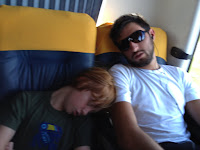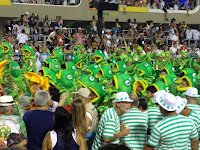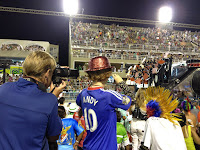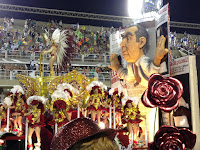We arrived without any real expectations, having added this stop at the spur of the moment. The countryside we traversed across coastal Uruguay was green and spacious ... interrupted by a few small but tidy ranch homes dotting the fields every few acres. The first impression is what a green countryside it is and also that properties look well-maintained and the roads virtually litter free.
Montevideo, the capital city of Uruguay, is a large city, but not by capital standards - it is tiny compared to Buenos Aires for instance. Nevertheless, it is home to a third of the 3.3 million population of Uruguay. While there are the usual gritty, run-down urban areas of most larger cities, for the most part it is a beautiful, well-maintained, well-preserved place.
I loved that the areas of the old city and the newer, trendier regions can thrive side by side. It is a town edged in by a curvy sea front that has stretches of rocky, grassy and sandy lengths to please everyone. there are wide grass margins along the roads and you can see people jogging, walking their dogs and picnicing along all the sea front areas every day. This contrasts with the more touristy sea fronts we've encountered in Rio, Buenos Aires and other large cities. Here, it feels like people really live in this area and have a good quality of life. It is not just another tourist destination.
The old part of the town, a peninsula stretching from the main sea port down pedestrianised streets to an old city gateway, is enchanting. The streets are lined with graceful cathedrals, colonial apartments and artistic commercial buildings that would make any architecture buff drool. This area is the most touristy, yet it has a local feel too. The streets are filled with local people shopping, dining and relaxing. Every few blocks we encountered yet another gorgeous park, with fountains and statues and more Uruguayans relaxing on benches.
The statistics on the country are impressive. It has been chosen by many polls as the most politically sound, crime-free, and 'green' of the latin american countries and boasts a high literacy rate. Uruguayan people appear to have one of the best standards of living in the Americas, a quiet gem in the busy continent.
The Uruguayans are huge fans of mate - the tea drink that argentinians are found sipping everywhere as well. Ask anyone where it originated and both countries will claim it came from theirs. In Uruguay, people are seen carrying the flasks of hot water under an arm and their mate cup and spoon/straw everywhere - in the parks, on the beaches, in the cafes. Someone joked to us that Uruguayan babies are born with the water flask and mate cup in their hands. Mate is just a tea leaf that is stuffed into this cup and slowly sipped all day long, topping up the hot water from time to time. As there's no milk or sugar involved and the tea leaves are recycled with hot water all day, it seems to be one of the healthiest drink options.
Our boys were drawn to the huge trees found in the green areas. We kept having to return to a special tree that Andy designated as His Tree. In the back of my mind were visions of His Tree in Galapagos where he fell and broke his arm. In any event, we were forced to take picnics to His Tree and visit it on return from our daily outings whenever possible. I took some comfort in the fact that Montevideo was more likely to have up to date medical facilities than the remote Galapagos islands.
The hostel we found was lovely too. Just outside of the old city in a more trendy, well-to-do area, the hostel, Montevio Up, was a homey oasis for us as we returned tired and hungry at the end of a day's trekking about. The two men who ran the hostel were constantly checking on all of us to see if we had everything we needed - towels, drink, something for the kids. The hostel was very generous and it felt like we were staying with family. We made meals in the well-equipped kitchen and met some lovely and very polite German students and an Australian couple amongst others.
We spent a good bit of time in the old city and one of our favourite parts was the Mercade del Puerto. This is a warehouse style marketplace decorated throughout with old-fashioned signs and iron work. It houses a number of Uruguayan grills or Parillas. Just before noon, all of these open sided grills have their fires up and going and are preparing cuts of beef, chicken and sausages to slow cook on the grills together. By 1 or 2 pm the places start filling up with people ready to eat. Our meals there were well-priced and we had some of the best grilled beef of our south american trip.
Another place we loved was a cathedral in the old city. In a lovely square where many people seemed to come for lunch, we found this cathedral quietly inviting. Andy in particular loved returning to visit. Inside, we would find a choir of chanting monks in the background, giving the place an other worldly feel. The children love to light a candle and have moments of silence and prayer. We all lit candles together and spent time reflecting on those that we have lost recently. We think of them often and we each have our special memories of them.
One odd sight in Montevideo was the occassional appearance in the street of horse and carts. They would be driven through the traffic by country folks who gathered cardboard, I assume for recycling, but wasn't able to find out.
At the park wth the old gate that marks the entrance to the old city, there are both the old and the new presidential palaces. To us, neither appear like a traditional governing palace, one quite small and the other too commercial. They make an interesting contrast side-by-side.
The children enjoyed a trip to the one of the many beaches. What I found interesting, between stopping Ben from drowining Sam, was that the water was fresh, not salty. It surprised me as everything about these beaches looks like your standard ocean front, sandy beaches with frothing ocean waves. But the water is actually from Rio de Plata, same as Buenos Aires. Unlike the water off the coast of Buenos Aires it is clear and not murky with silt as it is just that much further downstream. It's lovely to get soaked in the 'ocean' and come out without the usual sticky-sweaty feeling that wet salt and sun usually leave.
We did all that we could in 4 days in Montevideo and I think we exhausted most of the 'list' of touristy attractions as well as discovering our own favourite parks, beaches and Parillas.
view all photos:




































































